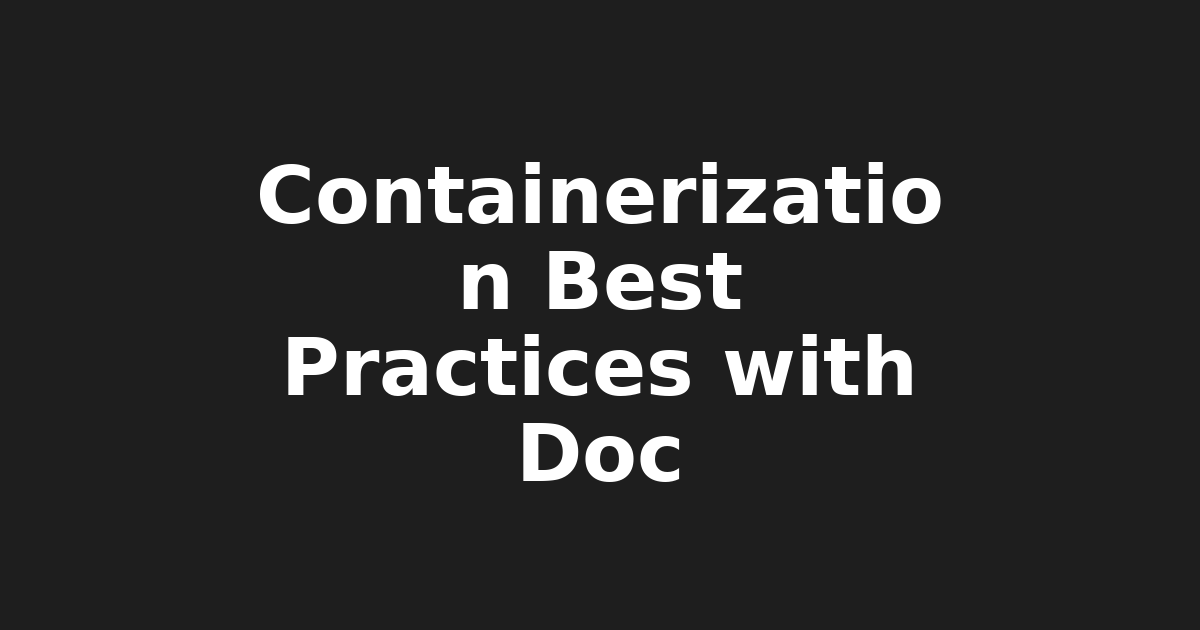Mastering Containerization with Docker & Kubernetes: Best Practices for IT…

Containerizing Your Way to Efficient Software Development: A Guide for Techies with Josh from KeepItTechie
Hello fellow tech enthusiasts! It's Josh here, your friendly Linux educator from KeepItTechie, and today we're diving into the fascinating world of containerization with Docker and Kubernetes. Containerization has taken the tech scene by storm, offering a powerful solution for software development, deployment, and scaling. Let's explore some best practices to make the most out of this innovative technology.
1. Embracing the Power of Containers and Microservices 🚀
Containers are like virtual houses for your applications and services. They encapsulate all dependencies needed to run an app, ensuring consistency across different environments. On the other hand, microservices allow us to break down monolithic applications into smaller, manageable pieces. A service mesh adds an extra layer of complexity management by providing intelligent traffic routing and security for these microservices.
2. Mastering Docker Image Management 🎨
When it comes to creating efficient Docker images, Dockerfiles, multi-stage builds, and caching mechanisms are your best friends. Think of a Dockerfile as a blueprint for your application container. With multi-stage builds, you can optimize your images by using multiple Dockerfiles at different stages during the build process. Caching mechanisms save time by reusing previously built layers when building new containers based on the same image.
3. Harnessing Docker Compose 🔌
Docker Compose is a fantastic tool for managing multiple services within a single application. With it, you can define and run multi-container Docker applications. It simplifies the process of working with distributed systems by handling dependencies and network configurations for you.
4. Security: Lock Down Your Containers 🔒
Containers might make your life easier, but they also introduce new security challenges. Image scanning helps identify vulnerabilities in base images before deployment. Network policies limit the traffic that containers can send and receive, while identity and access management (IAM) ensures secure communication between containers and services.
5. Kubernetes: Your Orchestrator 🎟️
Kubernetes, or K8s, is an open-source container orchestration tool that simplifies the deployment, scaling, and management of containerized applications. To deploy your app with Kubernetes, you'll need to set up a cluster, configure resources, and deploy your containers. K8s also offers advanced features like rolling updates, rollbacks, and blue-green deployments for smooth application updates.
6. Monitoring & Troubleshooting: Keeping an Eye on Things 🕵️♂️
Containerized applications can be tricky to monitor, but tools like Prometheus, Grafana, and Jaeger make observability a breeze. For logging, consider Kibana or the ELK Stack. Regularly monitoring your applications ensures that you catch and fix issues before they become major problems.
7. Designing for Microservices & Service Mesh 🛠️
In a Kubernetes environment, it's crucial to design microservices architecture, service mesh, and API gateways thoughtfully. Well-designed components provide better scalability, fault tolerance, and overall system performance.
8. Streamline Your CI/CD Pipeline 🏎️
Automate your CI/CD pipeline using tools like Jenkins, CircleCI, GitLab CI, or GitHub Actions. This streamlines application deployment and scaling, helping you stay efficient and agile in the ever-evolving tech landscape.
Remember: Staying updated with these best practices will empower you to optimize your containerization workflows, improve application performance, reduce costs, and ensure scalability in modern cloud-native applications. By 2025, it's projected that over 75% of enterprise IT organizations will be running containerized applications in production, so don't get left behind!
Keep It Simple, Keep It Techie! 🌐
As always, I hope these tips help you navigate the world of containerization with Docker and Kubernetes. Remember to stay curious, keep learning, and above all – have fun with technology! Happy coding!
🔑 Keywords: containerization, Docker, Kubernetes, microservices, service mesh, CI/CD, Linux, IT professionals
🔗 External Links: Docker, Kubernetes
🔗 Internal Links: Linux for Beginners
🙋♂️ This post was brought to you by Josh from KeepItTechie — helping you break into tech, one command at a time.
